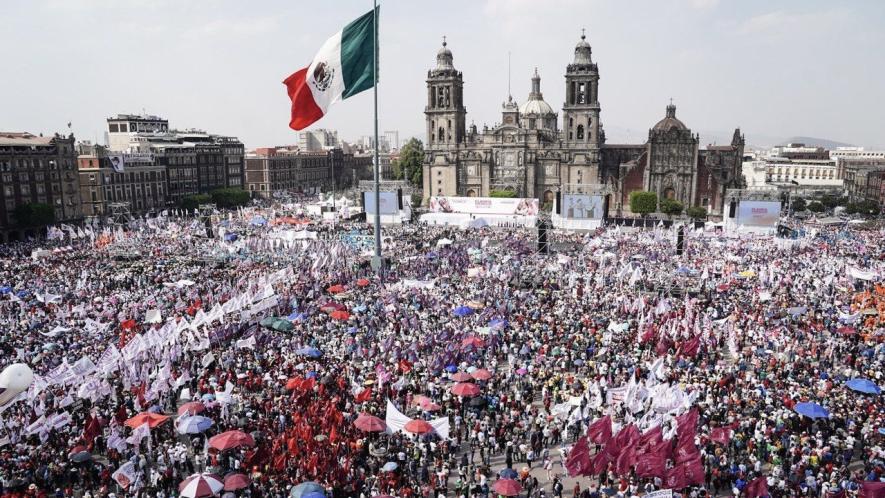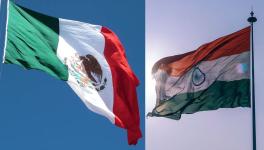What is 4T in Mexico? MORENA’s Project Under Debate

March 2024. The Zócalo in Mexico City was overflowing with people for the presidential campaign launch of Claudia Sheinbaum. Photo: Claudia Sheinbaum
The Tricontinental: Institute for Social Research published its Dossier No. 22, entitled “Mexico and the Fourth Transformation”, in which it evaluates the changes undertaken by the governments of the National Regeneration Movement (MORENA), the ruling party. To this end, they position the governments of Andrés Manuel López Obrador (AMLO, 2018-2024) and Claudia Sheinbaum (2024 to date), the current president, as part of a legacy of historical transformations in the Mesoamerican country.
The three transformations before MORENA
The dossier states that the first great Mexican transformation took place during the period of independence from Spain (1810-1821), when a “war of the masses” rose up against the social and political order imposed by the Spanish Crown. Independence thus left ideas such as “Mexican greatness” and the notion of a “tireless people with great ancestors” in the country’s historical memory.
The second major transformation was the War of Reform (1858-1861), in which liberals and conservatives fought each other in bloody battles, resulting in the creation of a liberal and federalist state, even against certain interests of the clergy and in favor of a nascent bourgeoisie. During this period, several imperialist invasions took place in the country: France invaded Mexico in 1838 and, years later, between 1861 and 1867; the United States seized half of Mexican territory in 1846. These invasions generated a shared nationalist sentiment, thus developing a sovereign and anti-monarchist national consciousness.
The Mexican Revolution (1910-1917) was, according to the text, the third great transformation. In it, popular and other sectors from northern and southern Mexico united to restructure the country. However, thanks to the support of the United States and other factors, the more moderate wing of the Revolution, led by Venustiano Carranza, triumphed over the more radical positions that advocated a deeper popular revolution. Although many of the demands of the popular sectors were incorporated into the 1917 constitution, a system of caudillos supporting the “Jefe Máximo” (Supreme Leader) was established in Mexico.
A complicated interstice
Thus, the study recounts how MORENA’s project is assumed to be the historical continuation of these processes. This self-conception of inheriting the most radical struggles in Mexican history is also based on a political commitment to legitimize its state project. In this way, the analysis explores a sort of genealogy of social and political activists, ranging from Father Hidalgo to Emiliano Zapata and Lázaro Cárdenas, and finally to the leaders of 21st-century Mexican reformism.
The dossier describes a watershed moment in the 20th century, when the country was controlled by the Mexican oligarchy, in the form of the government of Lázaro Cárdenas (1934-1940), who, according to the study, built the first left-wing government in Mexico’s history with projects such as agrarian reform, oil expropriation, the welfare state, etc. This project was betrayed by an authoritarian program carried out by the Institutional Revolutionary Party (PRI), which repressed socialist forces and social movements from 1940 onwards.
The publication argues that the armed path pursued by various political sectors of the left was abandoned in favor of an electoral path. However, other electoral projects, such as the Party of the Democratic Revolution (PRD), were unable to offer an alternative to the PRI’s control of the state due to internal divisions. Thus, MORENA emerged as the only viable and nationwide alternative to challenge the establishment’s control of the state at the end of the 20th century and the beginning of the 21st.
MORENA and the 4T
The fourth transformation (4T), the dossier asserts, would bring together a series of anti-neoliberal and democratic struggles that took place in Mexico between 1989 and 2018, ranging from the Zapatista uprising of 1994 to the student movement of 2012, to the movement demanding the truth about the disappearance of the 43 students from Ayotzinapa in 2014.
AMLO thus became a benchmark for progressive political alternatives, even though the publication itself acknowledges that he was often not personally involved in such social and political struggles. In any case, the study considers AMLO’s victory in 2018 a part of a “popular, plebeian, and nationalist” project.
Despite AMLO’s anti-neoliberal aspirations, there is no doubt that the country is still tied to “economic conditions that reproduce neoliberalism,” the text underscores. These conditions were developed over several decades in which the state abandoned its traditional participation in the economy. Since the 1980s, Mexico has been committed to trade liberalization and tariff reduction, which will materialize with the approval of the North American Free Trade Agreement (NAFTA). The privatization of public companies, tax reforms, and the reduction of public spending marked the state agenda.
Thus, the document clarifies, the role of Obradorism (a tendency related to AMLO) as a project of modifications, but not of radical economic transformations:
“In López Obrador’s discourse, neoliberalism is framed as a grand scheme of corruption and systematic impoverishment that benefitted only a small portion of the population. While this view may oversimplify a more complex reality, it aligns with the widely held perception that the reforms of the neoliberal period were an abuse of power by the ruling classes and that they unfairly and disproportionately benefitted those with access to power…The discourse on corruption has therefore resonated deeply with the majority of the population, who view the 4T as a bulwark against these abuses despite the absence of substantial changes to neoliberal economic policy.”
MORENA’s transformations
The report also highlights the specific changes made by MORENA governments: tax collection, nationalization of lithium, wage increases, recovery of energy sovereignty (especially in PEMEX, the national oil company), increased hydrocarbon production, construction of refineries, energy reform, etc.
In this regard, MORENA President Héctor Díaz Polanco stated: “[Morena] construct[ed] a new common sense, which included the fundamental task of demystifying everything that the triumphant, prevailing neoliberalism meant for the country. That was the structure that had to be defeated, which meant a very clear rejection of the idea that the market could solve society’s problems. To recall the classic idea that the market can regulate itself, we began from the premise that the market cannot regulate itself and that all the country’s problems stemmed from that initial idea.”
On the fight against neoliberalism, renowned historian Armando Bartra, a member of MORENA, clarifies: “When you come to power as part of the progressive left and you come from a process of exclusionary and impoverishing neoliberalism, you have a job, and that job is to reduce poverty. They are not telling you to build socialism. They are not telling you to break with capitalism. They are telling you to reduce poverty and restore hope. We want to live better, not worse – we want our children to have a better life with us. We want that and, moreover, we elected you for that.”
The governments of the Fourth Transformation have managed to lift 11 million people out of poverty through public investment, the implementation of social programs, and an increase in minimum wages (by almost 241%). On the other hand, the dossier affirms that, in accordance with the political pragmatism previously mentioned by Bartra, which has also been criticized both inside and outside Mexico, it is essential to take precautions with regard to the treaties signed with the United States, both economic and security-related.
Thus, according to the compilation, the latent contradictions and advances against neoliberalism are part of a positive balance: “The 4T’s record with respect to its central objective – overcoming neoliberalism and the inequalities it produced – is positive despite the contradictions that remain. Beyond what has been achieved in terms of constitutional reforms, the ideological battle against neoliberalism has been consistent and forceful, paving the way for deeper transformations in the future.”
A new hegemony?
The debate over whether MORENA’s so-called “Mexican humanism” is radical or not is not closed – a key point in the analysis – although a kind of national consensus necessary for the victory of the López Obrador and Sheinbaum governments has been established.
The dossier compiled interviews with prominent intellectuals, which reveal a recognition of internal tensions within the political project: “Paco Ignacio Taibo II, a writer, political activist, and the director of the Economic Culture Fund (Fondo de Cultura Económica), told us that Morena faces a contradiction: its openness, while necessary to gain electoral strength, also enabled the inclusion of former PRI members and others with varying ideological affinities to the transformation project, generating internal tensions within its political structure.
Morena seeks to build a left-leaning political project. Yet its internal diversity reflects a broad ideological spectrum, in part due to opportunistic affiliations that followed its consolidation as a dominant political force after coming to power. For the academic Diana Fuentes, this is not so much a result of Morena’s current weaknesses but rather stems from more than a century of Mexican political culture, marked by corporatism and caudillismo.”
The Tricontinental publication, despite everything, assumes that hegemony has indeed been achieved, at least in terms of the electoral contest and control over the public agenda, which can be problematic if we consider Gramsci’s definition of hegemony, which goes beyond the electoral and ideological dimensions: “The hegemony that Morena has built is evident in its overwhelming electoral victories, in its capacity to set the terms of national political debate, and in the absence of any real opposition from the right or any criticism or challenge to its project from the left. It is clear that the mass and triumphant character of the 4T has subsumed other left currents, which today remain marginal in both political and discursive terms.”
In this way, the investigation attempts to show that the 4T is a complex, multidimensional project that faces profound internal and external tensions. A simple categorization of a project such as MORENA’s would generate unreliable conclusions.
4T stands out as an undeniably unique process in many ways, and a continuation in others. Its history is still unfolding, and if we follow the history of Mexico, it will surely establish itself as a political force that will shape Mexican politics for several generations, even if we cannot yet neatly define the direction of its journey.
Courtesy: Peoples Dispatch
Get the latest reports & analysis with people's perspective on Protests, movements & deep analytical videos, discussions of the current affairs in your Telegram app. Subscribe to NewsClick's Telegram channel & get Real-Time updates on stories, as they get published on our website.
























